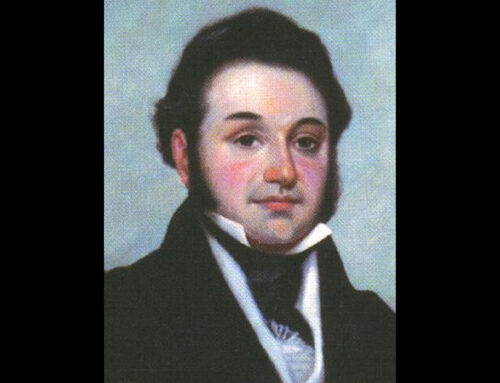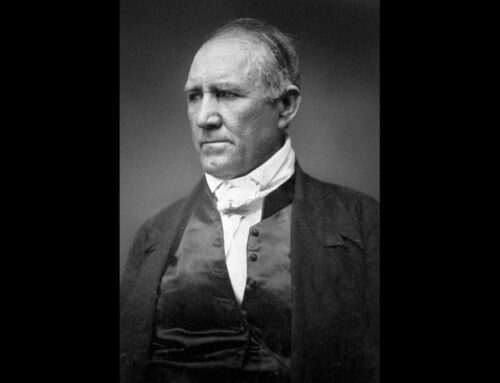Portrait of David Burnet. Image courtesy of the Texas State Library and Archives Commission. Image available on the Internet and included in accordance with Title 17 U.S.C. Section 107.
David G. Burnet: A Founding Figure in the Texas Revolution
David G. Burnet played a crucial role in the Texas Revolution, a pivotal conflict that eventually led to Texas gaining independence from Mexico.
Historical Context
The Texas Revolution
David G. Burnet was a pivotal figure in the early stages of the Texas Revolution, a conflict that eventually led to Texas gaining independence from Mexico. The revolution began in 1835 and was fueled by growing tensions between Anglo-American settlers and the Mexican government. Burnet played a crucial role by helping to draft the Texas Declaration of Independence, which was adopted on March 2, 1836. This document was instrumental in rallying support for the Texan cause and formally severing ties with Mexico.
Read more about the Texas Declaration of Independence.
Interim Presidency
Following the declaration, Burnet was appointed as the interim president of the nascent Republic of Texas on March 17, 1836. His presidency was marked by immediate and significant challenges, including organizing a new government and dealing with the ongoing threat from Mexican forces under General Santa Anna. Burnet’s leadership during this critical period was essential in laying the groundwork for the Republic’s governance and defense.
Discover more about General Santa Anna’s role in the Texas Revolution.
Personal Background
Early Life
David Gouverneur Burnet was born on April 14, 1788, in Newark, New Jersey. He was the youngest of eight children in a prominent family. Burnet’s early life was marked by a series of ventures that took him far from home. In 1806, he traveled to the Spanish territory of Texas but eventually returned to the United States due to health issues. He moved to Texas permanently in 1826, where he began to establish himself in local politics and business.
Learn more about the early settlers of Texas.
Career Before Settling in Texas
Before settling in Texas, Burnet pursued various careers. He studied law and became a lawyer, but he was also involved in land speculation and other business ventures. These experiences gave him a diverse skill set that proved valuable in his later political career. Burnet’s move to Texas was driven by the opportunities he saw in the region, and he quickly became an influential figure in the community.
Achievements and Challenges
Interim Presidency
As interim president, Burnet’s administration focused on solidifying the new Republic’s government and defending against Mexican forces. One of his significant achievements was the establishment of a functioning government framework during a time of war. However, his tenure was not without controversy. Burnet faced criticism for his handling of various military and diplomatic matters, most notably the Goliad Massacre.
Controversies
The Goliad Massacre was a pivotal and tragic event during the Texas Revolution. In March 1836, Texan forces were captured by the Mexican army and later executed under the orders of General Santa Anna. Burnet’s administration was criticized for not preventing the massacre and for its overall handling of prisoners. These controversies marred his presidency and overshadowed some of his contributions.
Explore the details of the Goliad Massacre.
Legacy and Impact
Long-term Contributions
Despite his brief and tumultuous presidency, Burnet’s contributions were significant. He helped lay the foundation for the Republic of Texas, which later became the state of Texas. His efforts in organizing the government and maintaining a semblance of order during a chaotic period were crucial. Burnet’s work in the early days of the Republic set the stage for future leaders to build upon.
Modern Perspectives
Today, David G. Burnet is often overshadowed by more prominent figures such as Sam Houston. However, historians recognize his role as a key early leader in Texas history. Burnet’s presidency, though controversial, was a critical period in the fight for Texas independence. His legacy is one of perseverance and dedication to the cause of Texan liberty.
Key Events and Contributions
Goliad Massacre
The Goliad Massacre remains one of the most controversial aspects of Burnet’s presidency. The execution of Texan prisoners by Mexican forces was a significant blow to the revolutionaries and a source of outrage among Texans. Burnet’s role in the aftermath of the massacre has been debated by historians, with some criticizing his lack of decisive action to prevent the tragedy.
Retirement and Continued Service
After his presidency, Burnet continued to serve Texas in various capacities. He was elected Vice President under Mirabeau B. Lamar and later served as Secretary of State. Burnet’s later years were marked by continued involvement in Texas politics and efforts to support the development of the young Republic. His dedication to Texas remained steadfast until his death in 1870.
The Fight for Independence
Texas Independence Movement
David G. Burnet was part of a larger movement of Anglo-American settlers seeking independence from Mexican rule. This movement was driven by cultural and political differences between the settlers and the Mexican government. The desire for self-governance and the protection of individual rights were central themes in the push for independence. Burnet’s leadership was instrumental in advancing these goals and securing a future for Texas as an independent republic.
Conclusion
David G. Burnet’s role in the Texas Revolution and the early days of the Republic of Texas highlights his dedication to the cause of independence. His leadership during the Texas Revolution, particularly in drafting the Texas Declaration of Independence and serving as interim president, was crucial in the struggle for Texan liberty. Despite the controversies, such as the Goliad Massacre, Burnet’s contributions helped lay the foundation for the Republic of Texas.
While often overshadowed by figures like Sam Houston, Burnet’s legacy as an early leader remains significant. His efforts in establishing a new government, handling the immediate threats from Mexican forces, and navigating the turbulent early days of the Republic reflect his resilience and commitment. Burnet’s later years of continued public service further underscore his dedication to Texas.
Burnet’s story is a reminder of the complex and often challenging journey toward independence. His leadership and actions, amidst criticism and controversy, played a pivotal role in shaping the future of Texas. By understanding Burnet’s contributions and the context in which he operated, we gain a deeper appreciation of the early struggles and triumphs that defined Texas history.
Learn More About the Republic of Texas Presidents & Vice Presidents
Explore the lives and contributions of other key figures in the Republic of Texas:
- David Burnet
- Sam Houston
- Mirabeau B. Lamar
- Anson Jones
- Lorenzo de Zavala
- Edward Burleson
- Kenneth Anderson



